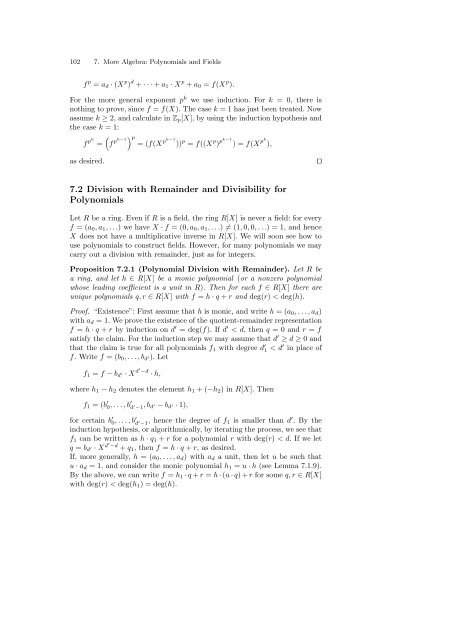Dietzfelbinger M. Primality testing in polynomial time ... - tiera.ru
Dietzfelbinger M. Primality testing in polynomial time ... - tiera.ru
Dietzfelbinger M. Primality testing in polynomial time ... - tiera.ru
You also want an ePaper? Increase the reach of your titles
YUMPU automatically turns print PDFs into web optimized ePapers that Google loves.
102 7. More Algebra: Polynomials and Fields<br />
f p = ad · (X p ) d + ···+ a1 · X p + a0 = f(X p ).<br />
For the more general exponent p k we use <strong>in</strong>duction. For k = 0, there is<br />
noth<strong>in</strong>gtoprove,s<strong>in</strong>cef = f(X). The case k = 1 has just been treated. Now<br />
assume k ≥ 2, and calculate <strong>in</strong> Zp[X], by us<strong>in</strong>g the <strong>in</strong>duction hypothesis and<br />
the case k =1:<br />
f pk<br />
=<br />
�<br />
f pk−1� p<br />
=(f(X pk−1<br />
)) p = f((X p ) pk−1<br />
)=f(X pk<br />
),<br />
as desired. ⊓⊔<br />
7.2 Division with Rema<strong>in</strong>der and Divisibility for<br />
Polynomials<br />
Let R be a r<strong>in</strong>g. Even if R is a field, the r<strong>in</strong>g R[X] is never a field: for every<br />
f =(a0,a1,...)wehaveX · f =(0,a0,a1,...) �= (1, 0, 0,...) = 1, and hence<br />
X does not have a multiplicative <strong>in</strong>verse <strong>in</strong> R[X]. We will soon see how to<br />
use <strong>polynomial</strong>s to const<strong>ru</strong>ct fields. However, for many <strong>polynomial</strong>s we may<br />
carry out a division with rema<strong>in</strong>der, just as for <strong>in</strong>tegers.<br />
Proposition 7.2.1 (Polynomial Division with Rema<strong>in</strong>der). Let R be<br />
ar<strong>in</strong>g,andleth ∈ R[X] be a monic <strong>polynomial</strong> (or a nonzero <strong>polynomial</strong><br />
whose lead<strong>in</strong>g coefficient is a unit <strong>in</strong> R). Then for each f ∈ R[X] there are<br />
unique <strong>polynomial</strong>s q, r ∈ R[X] with f = h · q + r and deg(r) < deg(h).<br />
Proof. “Existence”: First assume that h is monic, and write h =(a0,...,ad)<br />
with ad = 1. We prove the existence of the quotient-rema<strong>in</strong>der representation<br />
f = h · q + r by <strong>in</strong>duction on d ′ =deg(f). If d ′












